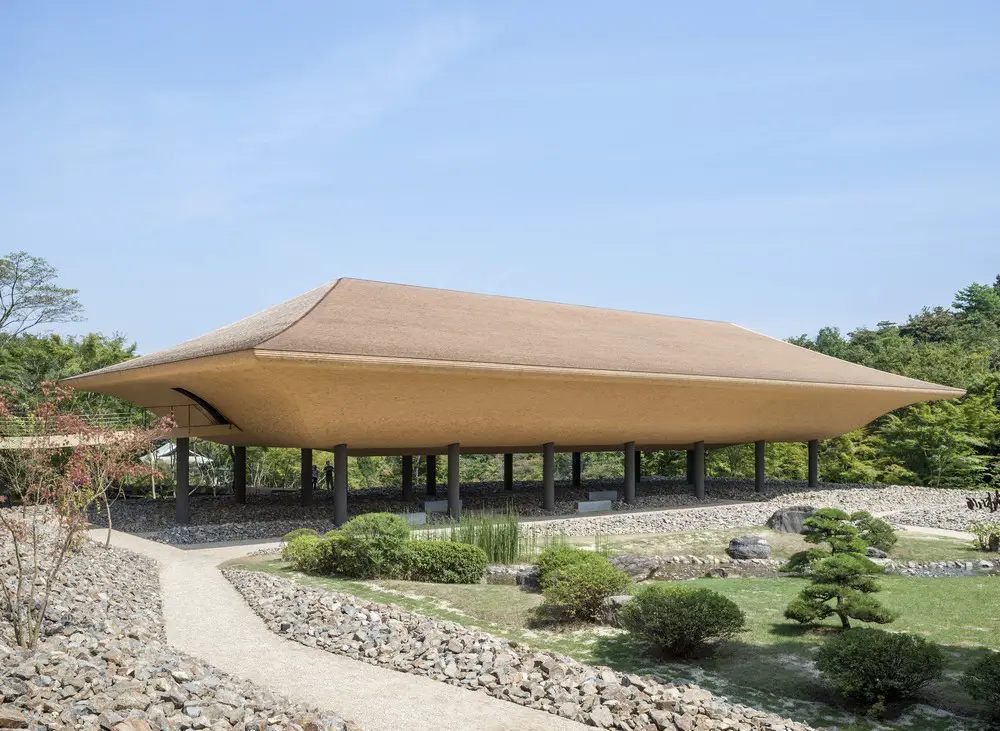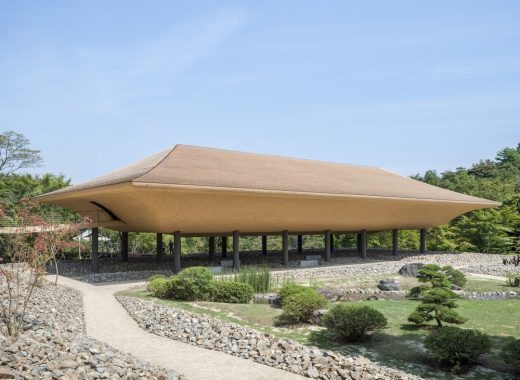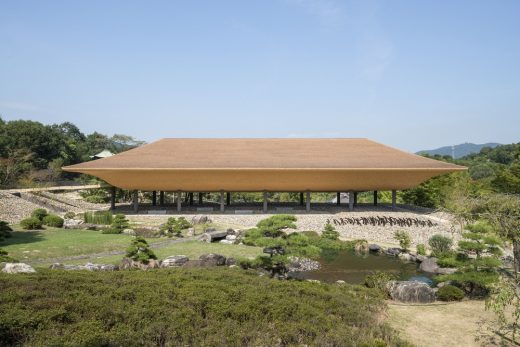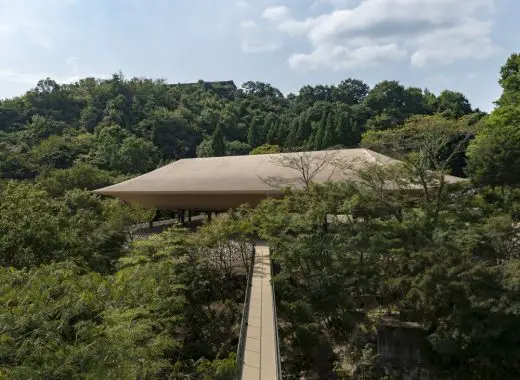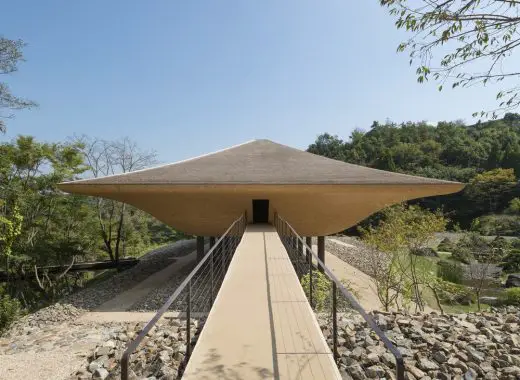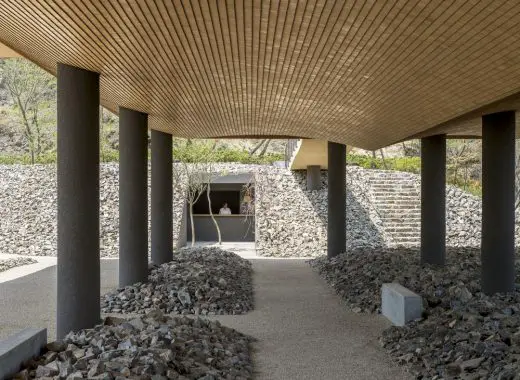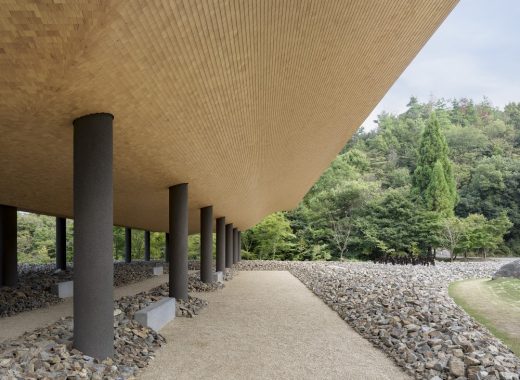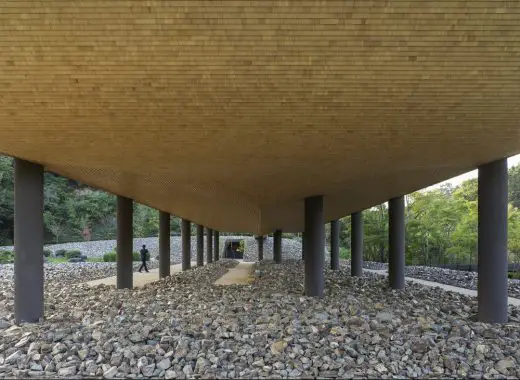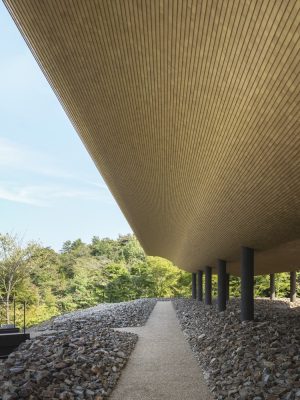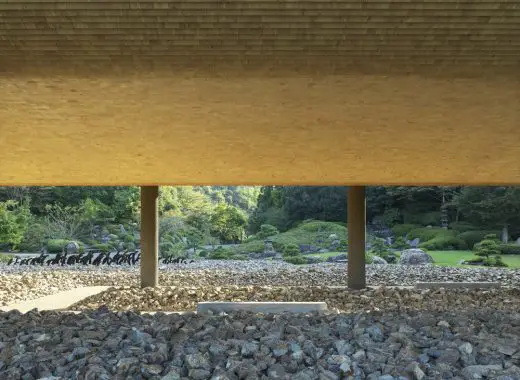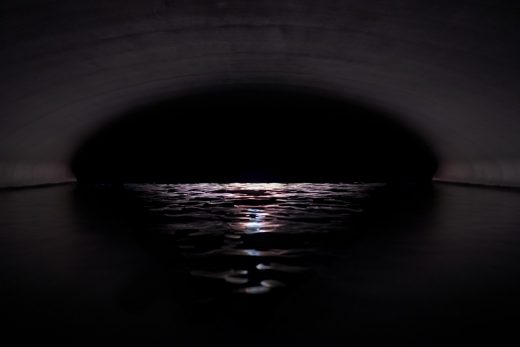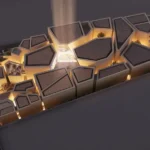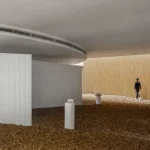Kohtei Art Pavilion, Japanese Design, Shinshoji Zen Museum Building, Architecture Images
Kohtei Art Pavilion in Hiroshima
Shinshoji Zen Museum and Gardens Development in Japan – design by SANDWICH Inc.
13 Jul 2017
Kohtei Art Pavilion
Location: Kamisanna 91, Numakuma-cho, Fukuyama, Hiroshima Prefecture 720-0401, Japan
Architect: Kohei Nawa | SANDWICH Inc. (Yoshitaka Lee, Yuichi Kodai)
Kohtei Art Pavilion
The temple was founded by the shipbuilding company to console the spirit of the dead in accidents at sea and industry. Visitors can expect a memorable Zen experience at the complex. KOHTEI offers the visitors an opportunity to contemplate spirit of Zen by looking at its landscape/gardens and being subjected to a meditation like experience through its art installation. The building is designed by Japanese contemporary artist, Kohei Nawa and SANDWICH. The architecture within SANDWICH was directed by Lee Yoshitaka and Yuichi Kodai.
The approach from a seamless and minimal footbridge, provides the visitor with a breathtaking first impression. Kohtei’s distinctive form was inspired from the roots of temple’s establishment which led to create a building that resembles the motif of a ship. It is “an architecture that floats on waves surrounded by mountains” and is themed to work with three fundamental materials “Wood”,“Stone” and “Water”.
The ship-shaped building, covered with wood shingles that uses the traditional Kokera roofing technique floats above the stony landscape. Walking through the ocean of stones, full of materiality, one goes up the gently sloping walkway to reach the entrance of the building. Upon entering the interior, a quietly rippling ocean with glimmers unfolds in the darkness. ~ Kohei Nawa
The body of the pavilion is entirely covered with Sawara wood (Japanese cypress) that seems to hover above the landscape creating underneath a piloti space. The woodwork on the roof was laid using Kokera-buki, a traditional roofing technique that is available in Japan for thousands of years. This is a kind of shingle roofing where instead the tiles are 100mm x 300mm x 3mm thick, and 9 layers of tiles are fixed with bamboo nails making one roof compound. In total, 340,000 pieces were laid by the16th generation roofing master based in Kyoto. For the soffit, 250,000 pieces of 100mm x 100mm Sawara wood tiles were used in order to give a monolithic appearance to the pavilion. The experience of standing underneath such space enhances the stark materiality of the landscape against the airy contours of the wooden roof. Surrounding views are framed and visitors can experience ever changing sceneries.
The stone landscape represents the ocean in which the ship smoothly floats. The rugged stone has a high content of iron that rusts over the time. It was brought from nearby quarries unrefined and in its original state just as the dynamite blasted it off the face of the cliff, where each stone varies in size and shape, and where its sharp edges provide a strong effect of contrasting light and shadow to the surrounding groundscape. The path guides the visitors through the landscape, garden and building providing them with as one seamless experience, allowing them to perceive the building in its multiple aspects.
The path gradually leads the visitors into the interior of the vessel-like roof through a small entrance where one finds an installation spreading in the darkness. The installation represents the immensity of the ocean and visitors can experience meditation while observing the shimmering lights reflected on the quietly rippling water waves. The darkness together with the faint sound of the room, curiously sharpens the visitor’s vision and auditory senses.
Each individual will sense the meditative time and space differently. It was not intended to directly express Zen, but visitors retain the memories of their visit and have the opportunity to consider the sensibility and philosophy of Zen. KOHTEI is a structure that exterior, interior and underneath space reflects the enfolding experience of being in the mountains, creating work that combines both physical and mental experiences. KOHTEI aims to generate creative expressions of inseparably integrated architectural functions: the reality created by the materials and textures, and the experiences they engender.
Kohtei Art Pavilion in Hiroshima – Building Information
Temple Site: 23 ha
Site area: 4700 sqm
Built area: 796 sqm
Size: 46m x 19m x 10m h
Structure: Steel
Roof : Kokerabuki (Sawara Wood)
Soffit : Wood Shingle (Sawara Wood)
Design and Installation
Architect: Kohei Nawa | SANDWICH Inc. (Yoshitaka Lee, Yuichi Kodai)
Art Installation: Kohei Nawa | WOW Inc.
Sound: Marihiko Hara
Project Team
Design and Supervision: Kohei Nawa | SANDWICH (Yoshitaka Lee, Yuichi Kodai)
Installation: Kohei Nawa | WOW
Sound: Marihiko Hara
Structural design: Shizuo Tonomura of Ascoral Engineering Associates
Equipment design: Yamada Hiroyuki of Yamada Machinery Office
Roofing: Yoshifumi Miyagawa of Miyagawa Roof Company
Lighting Design: Izumi Okayasu of Izumi Okayasu Lighting Design
Construction: Daiwa Construction
Landscape Supervision: Seijun Nishihata (Sora Botanical Garden)
Graphic design (logos, signs and tools): Yuma Harada and Keisuke Yamazoe of UMA/design farm
Project management: Toshiko Ferrier of Office Ferrier
SANDWICH Credits:
Directors: Kohei Nawa, Yoshitaka Lee, Yuichi Kodai, Staff: Gyoto Seto, Hiroto Hojo, Noriko Horie, Hitomi Enoki, Kotaro Ashida, Yasuharu Tamai, Kei Yasuda, Sho Nishihara, Luigi Honorat, Masuo Yamaguchi, Yohji Komai, Ma-satoshi Hatamoto, Futoshi Kinoshita
Photography: Nobutada OMOTE | SANDWICH
Address: Kamisanna 91, Numakuma-cho, Fukuyama, Hiroshima Prefecture 720-0401, Japan
Telephone: +81 84-988-1111 (Temple Office)
Website: Shinshoji Zen Museum and Gardens
Kohtei Art Pavilion in Hiroshima images / information received 130717
Location: Hiroshima, Japan, East Asia
Japan Architecture Designs
Contemporary Japan Architectural Selection
Japanese Architecture Design – chronological list
Japanese Architecture – Selection
Gallery in Kiyosato Villa With Exhibition Space, Kiyosato, Hokuto, Yamanashi
Architect: Satoshi Okada Architects
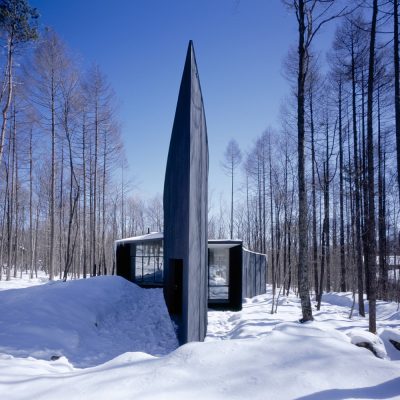
photographer: Koichi Torimura ; Copyrights belong to Satoshi Okada architects Inc., 2006
Gallery in Kiyosato Villa With Exhibition Space
Contemporary University Classroom, Ishikawa, Chubu region, Honshu island
Design: KELUN
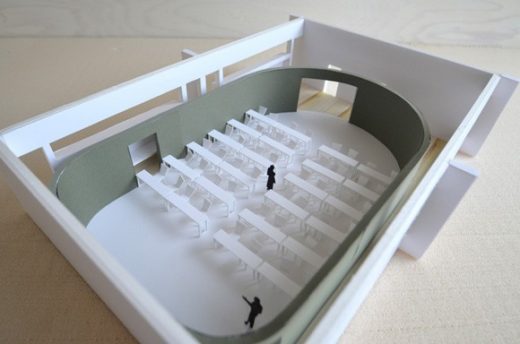
photo : Yasuhito Inamori
Blackboard Classroom in Ishikawa by Kelun
Contemporary Houses : Designs + Images from around the world
Comments / photos for the Kohtei Art Pavilion in Hiroshima – New Japanese Residence page welcome
Website : Japan

